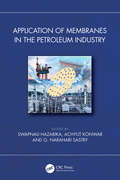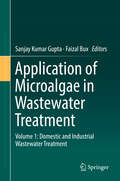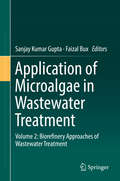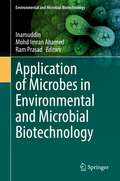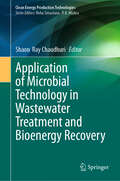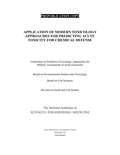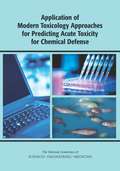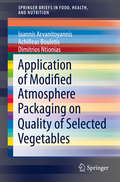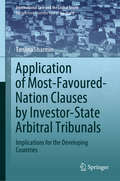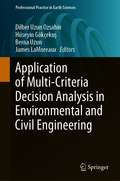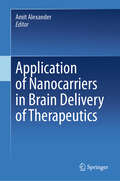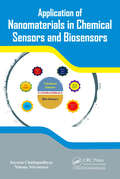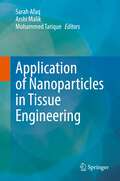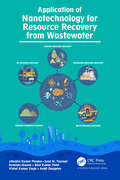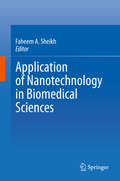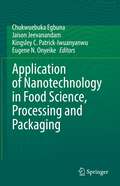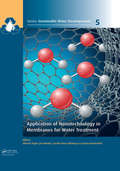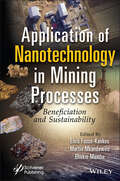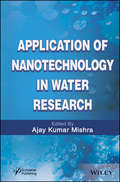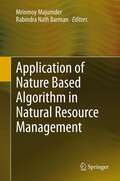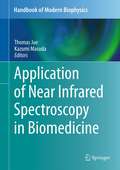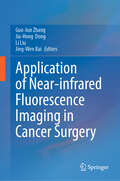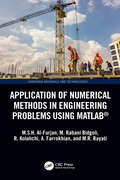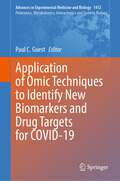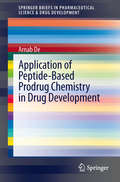- Table View
- List View
Application of Membranes in the Petroleum Industry
by Swapnali Hazarika Achyut Konwar G. Narahari SastryThis book focuses on the advantageous features of membrane technology in petroleum industries, with an emphasis on membrane materials and the application of membranes in the separation of olefin–paraffin, oil–water, aliphatic–aromatics, heavy metals, etc., along with other applications like waste management, sulphur emission, enhanced oil recovery and so forth. It also discusses the design and development of membranes from novel materials, the challenges of new materials for membrane applications, membrane-based processes and the application of novel membrane-based processes in the petroleum industry.Features: Addresses the fundamental applications of membranes in petroleum industrial separation processes Highlights the role of membrane technology in waste management in petroleum industries Includes novel engineered membrane materials Discusses methods of extracting valuable substances from produced water and membrane fouling control Emphasises solving industrial problems pertinent to membrane usage This book is aimed at researchers and graduate students in chemical and petroleum engineering and membrane technology.
Application of Microalgae in Wastewater Treatment: Volume 1: Domestic and Industrial Wastewater Treatment
by Faizal Bux Sanjay Kumar GuptaThis two-volume work presents comprehensive, accurate information on the present status and contemporary development in phycoremediation of various types of domestic and industrial wastewaters. The volume covers a mechanistic understanding of microalgae based treatment of wastewaters, including current challenges in the treatment of various organic and inorganic pollutants, and future opportunities of bioremediation of wastewater and industrial effluents on an algal platform. The editors compile the work of authors from around the globe, providing insight on key issues and state-of-the-art developments in algal bioremediation that is missing from the currently available body of literature. The volume hopes to serve as a much needed resource for professors, researchers and scientists interested in microalgae applications for wastewater treatment. Volume 1 focuses on the different aspects of domestic and industrial wastewater treatment by microalgae. The case studies include examples such as genetic technologies as well as the development and efficient use of designer consortia for enhanced utilization of microalgae. This volume provides thorough and comprehensive information on removal of persistent and highly toxic contaminants such as heavy metals, organic pesticides, polyaromatic hydrocarbons, endocrine disruptors, pharmaceutical compounds, and dyes from wastewater by microalgae, diatoms, and blue-green algae. Design considerations for algal ponds and efficient use of photobioreactors and HRAPs for wastewater treatment are some other highlights. This volume addresses the applications, potentials, and future opportunities for these various considerations in water pollution mitigation using algal technologies.
Application of Microalgae in Wastewater Treatment: Volume 2: Biorefinery Approaches of Wastewater Treatment
by Faizal Bux Sanjay Kumar GuptaThis two-volume work presents comprehensive, accurate information on the present status and contemporary development in phycoremediation of various types of domestic and industrial wastewaters. The volume covers a mechanistic understanding of microalgae based treatment of wastewaters, including current challenges in the treatment of various organic and inorganic pollutants, and future opportunities of bioremediation of wastewater and industrial effluents on an algal platform. The editors compile the work of authors from around the globe, providing insight on key issues and state-of-the-art developments in algal bioremediation that is missing from the currently available body of literature. The volume hopes to serve as a much needed resource for professors, researchers and scientists interested in microalgae applications for wastewater treatment. Volume 2 addresses the various biorefinery aspects and applications of algal-based wastewater treatment in industrial and domestic contexts. The analyses are approached from multiple perspectives, including biotechnology, commercial, economic, and sustainability. The authors discuss the potential of microalgae for integrated biomass production utilizing various resources to treat wastewaters, and include evaluations of the economical and commercialization potential for such processes.
Application of Microbes in Environmental and Microbial Biotechnology (Environmental and Microbial Biotechnology)
by Inamuddin Ram Prasad Mohd Imran AhamedThis comprehensive edited book on microbial prospective discusses the innovative approaches and investigation strategies, as well as provides a broad spectrum of the cutting-edge research on the processing, properties and technological developments of microbial products and their applications. Microbes finds very important applications in our lives including industries and food processing. They are widely used in the fermentation of beverages, processing of dairy products, production of pharmaceuticals, chemicals, enzymes, proteins and biomaterials; conversion of biomass into fuel, fuel cell technology, health and environmental sectors. Some of these products are produced commercially, while others are potentially valuable in biotechnology. Microorganisms are considered invaluable in research as model organisms. This is a useful compilation for students and researchers in microbiology, biotechnology and chemical industries.
Application of Microbial Technology in Wastewater Treatment and Bioenergy Recovery (Clean Energy Production Technologies)
by Shaon Ray ChaudhuriThis book explores microbial intervention in wastewater treatment for resource recovery, bioenergy production, and environmental sustainability. It discusses the fate of pollutants, challenges in existing treatment strategies, and the need for innovation. Case studies illustrate wastewater-specific treatment strategies for bioenergy and resource recovery at different scales. The book emphasizes the use of wastewater for resource recovery through sequestration or biotransformation and highlights tailormade consortium development for sludge-free treatment. It also covers sustainable approaches like microbial biofilm reactors, microbial fuel cells and membrane technology for wastewater treatment. It also deals with nanotechnology in combination with microbial technology for handling refractory components in wastewater that could not be handled by microbes alone. This book provides insights into microbial technology for a clean environment and bioenergy production through a reduce, recover, and reuse approach. This valuable resource offers practical information that can be applied by engineers, researchers, and undergraduate and graduate students, as well as business professionals in the bioenergy field, aiding them in the implementation of renewable energy projects.
Application of Modern Toxicology Approaches for Predicting Acute Toxicity for Chemical Defense
by Committee on Predictive-Toxicology Approaches for Military Assessments of Acute ExposuresThe US Department of Defense (DOD) is faced with an overwhelming task in evaluating chemicals that could potentially pose a threat to its deployed personnel. There are over 84,000 registered chemicals, and testing them with traditional toxicity-testing methods is not feasible in terms of time or money. In recent years, there has been a concerted effort to develop new approaches to toxicity testing that incorporate advances in systems biology, toxicogenomics, bioinformatics, and computational toxicology. Given the advances, DOD asked the National Research Council to determine how DOD could use modern approaches for predicting chemical toxicity in its efforts to prevent debilitating, acute exposures to deployed personnel. This report provides an overall conceptual approach that DOD could use to develop a predictive toxicology system. "Application of Modern Toxicology Approaches for Predicting Acute Toxicity for Chemical Defense" reviews the current state of computational and high-throughput approaches for predicting acute toxicity and suggests methods for integrating data and predictions. This report concludes with lessons learned from current high-throughput screening programs and suggests some initial steps for DOD investment.
Application of Modern Toxicology Approaches for Predicting Acute Toxicity for Chemical Defense
by Committee on Predictive-Toxicology Approaches for Military Assessments of Acute ExposuresThe US Department of Defense (DOD) is faced with an overwhelming task in evaluating chemicals that could potentially pose a threat to its deployed personnel. There are over 84,000 registered chemicals, and testing them with traditional toxicity-testing methods is not feasible in terms of time or money. In recent years, there has been a concerted effort to develop new approaches to toxicity testing that incorporate advances in systems biology, toxicogenomics, bioinformatics, and computational toxicology. Given the advances, DOD asked the National Research Council to determine how DOD could use modern approaches for predicting chemical toxicity in its efforts to prevent debilitating, acute exposures to deployed personnel. This report provides an overall conceptual approach that DOD could use to develop a predictive toxicology system. "Application of Modern Toxicology Approaches for Predicting Acute Toxicity for Chemical Defense" reviews the current state of computational and high-throughput approaches for predicting acute toxicity and suggests methods for integrating data and predictions. This report concludes with lessons learned from current high-throughput screening programs and suggests some initial steps for DOD investment.
Application of Modified Atmosphere Packaging on Quality of Selected Vegetables (SpringerBriefs in Food, Health, and Nutrition)
by Ioannis Arvanitoyannis Achilleas Bouletis Dimitrios NtioniasThis Brief critically reviews the applied techniques in all the studied vegetables and summarizes the effect of modified atmosphere packaging (MAP) in all the quality parameters. In a brief introduction chemical and microbiological parameters that affect shelf life are mentioned, followed by a definition of modified atmosphere packaging. The referred vegetables are categorized into 10 categories: roots, tubers, leafy vegetables, fruits-vegetables, bulbs, stems and shoots, flowers, seeds, fungi and other. The effect of selected MAP applications on the shelf life of the vegetables is also highlighted. Along with atmosphere modification, several storage parameters such as temperature, several pretreatments, film permeability or light and dark storage conditions are studied and their interaction on the quality of the product is also taken under consideration. The increasing demand for healthier and "safer" foods has led the food industry in pursuit of storage technologies that will serve the primary role of storage life prolongation but with no sacrifice on nutritional value and without the presence of additives. MAP is a storage technique that has already proven to be effective in extending the shelf life of the product by reducing respiration rate and preserving all its quality characteristics. Due to many physiological factors that affect the shelf life of minimally processed vegetables (respiration rate, ethylene production, maturation and ripening) the selection of the ideal storage parameters (gas mixture, storage temperature, packaging film, and treatments prior to packaging) of MAP is a challenging procedure and must be planned carefully.
Application of Most-Favoured-Nation Clauses by Investor-State Arbitral Tribunals: Implications for the Developing Countries (International Law and the Global South)
by Tanjina SharminThis book comprehensively examines various issues regarding the scope of Most-Favoured Nation (MFN) Clauses in International Investment Agreements (IIAs), and addresses the reform, interpretation, and enforcement of IIAs with a specific focus on the MFN clause. The book begins with a study of the history and evolution of the MFN. It then presents a substantive analysis focusing on the drafting style and how it affects the scope of the MFN; rules of interpretation and arbitral case law on the scope of the MFN, procedural prerequisites to arbitration and jurisdiction of arbitral tribunals, and the implications of adopting an expansive approach to the MFN clause. The book’s argument centres on the need for arbitral tribunals to interpret the MFN in a manner that reflects the expressed intent of the parties. This requires taking into consideration the text of the MFN, its purpose, and the overall context of the IIA, rather than relying on values and assumptions that have nothing to do with the original intent of the parties. In making this argument, the book draws on Articles 31 and 32 of the Vienna Convention on the Law of Treaties and other interpretative rules. What sets the book apart is its comprehensive coverage of issues concerning the interpretation and application of the MFN in IIAs. At the same time, it addresses issues in connection with an expansive interpretation of MFN clauses, as well as concerns regarding the legitimacy crisis in investor-state arbitration. Accordingly, it contributes to future Investor-State Dispute Settlement (ISDS) reform, while also offering a wealth of theoretical and practical insights for future treaty drafters, arbitrators, and policymakers.
Application of Multi-Criteria Decision Analysis in Environmental and Civil Engineering (Professional Practice in Earth Sciences)
by Dilber Uzun Ozsahin Hüseyin Gökçekuş Berna Uzun James LaMoreauxThe use of a multi-criteria, decision-making theory was first studied in the 1970s. Its application in civil and environmental engineering is a new approach which can be enormously helpful for manufacturing companies, students, managers, engineers, etc. The purpose of this book is to provide a resource for students and researchers that includes current application of a multi-criteria, decision-making theory in various fields such as: environment, healthcare and engineering. In addition, practical application are shown for students manually. In real life problems there are many critical parameters (criteria) that can directly or indirectly affect the consequences of different decisions. Application of a multi-criteria, decision-making theory is basically the use of computational methods that incorporate several criteria and order of preference in evaluating and selecting the best option among many alternatives based on the desired outcome.
Application of Nanocarriers in Brain Delivery of Therapeutics
by Amit AlexanderThis book presents nanoparticles as potential drug delivery carriers for overcoming the blood-brain barrier. The initial chapter of the book discusses complex brain disorders, the currently available therapies, and their limitations. The book discusses the potential applications of polymeric nanoparticles, lipid nanocarriers, liposomes, inorganic nanoparticles, dendrimers, and stimuli-responsive polymers for targeted brain drug delivery. Further, it evaluates the development and role of different cell lines and animal models in brain research. Towards the end, the book reviews challenges, safety, toxicity, regulatory aspects, future possibilities, and constraints in the clinical translation of nanocarrier systems to treat neurological disorders. The book as such provides valuable information to neuroscientists, and researchers working in pharmaceuticals, nanomedicine, drug delivery research, and nanotechnology.
Application of Nanomaterials in Chemical Sensors and Biosensors
by Jayeeta Chattopadhyay Nimmy SrivastavaRecent advances in nanotechnology has led the nanomaterials into the realm of sensing applications. This descriptive book utilizes a multi-disciplinary approach to provide extensive information about sensors and elucidates the impact of nanotechnology on development of chemical and biosensors for diversified applications. The main focus of this book is not only the inclusion of various research works, which have already been reported in literature, but also to make a potential conclusion about the mechanism behind this. This book will serve as an invaluable tool for both frontline researchers and academicians to work towards the future development of nanotechnology in sensing devices.
Application of Nanoparticles in Tissue Engineering
by Arshi Malik Sarah Afaq Mohammed TariqueThis book discusses advancements in the applications of nanoparticles in tissue engineering. It examines the applications of nanobiomaterials in hard tissue regeneration, fabrication, and characterization. The book also analyzes the implication of three-dimensional and four-dimensional fabrication techniques for the production of the scaffold in tissue engineering and their advantages over conventional scaffold production techniques. Further, it presents smart materials used in making 4-D scaffolds that imitate the dynamic response of tissue against natural stimuli and adapt to the microenvironment by changing their conformation or other properties. It also summarizes the growing field of biomolecular detection and biosensors in tissue engineering and the increasing prominence of nanoparticles in the biosensors. Further, it provides the future outlook and associated challenges of the application of nanomaterials in tissue engineering.
Application of Nanotechnology for Resource Recovery from Wastewater
by Jitendra Kumar Pandey Vishal Kumar Singh Syed M. Tauseef Suvendu Manna Ravi Kumar Patel Ankit DasgotraMost of the time, industrial wastes contain recoverable resources that would be useful in other applications. For example, greywater have enough nutrient to support the growth of microalgal biomass that are useful for biofuel production. Similarly, solid waste generated in metal extraction industries often contain high concentration of other metals that could be extracted using various processes. This book presents a critical overview on the current nanotechnologies that are being utilized for extraction of valuable resources from various industrial and domestic wastes. This book presents research, reviews, and case studies on the extraction of metal, organic compounds, energy and nutrients from waste through nanotechnological interventions.
Application of Nanotechnology in Biomedical Sciences
by Faheem A. SheikhThis book highlights the wide applications of nanomaterials in healthcare and environmental remediation. Presenting nano-based materials that positively influence the growth and proliferation of cells present in soft and hard tissue and are used for the regeneration bone tissue and/or suppression of cancer cells, it also discusses the natural products that can be incorporated in nanofibers for the treatment of cancer. Further, it describes the use of blending and functionalization to produce chitosan nanofibers for biomedical applications, and reviews the role of plasma-enhanced gold nanoparticles in diagnostics and therapeutics. Lastly, the book also introduces various nanotechnology approaches for the removal of waste metabolites in drinking water, and explores the emerging applications of nanorobotics in medicine. Given its scope, this book is a valuable resource for scientists, clinicians, engineers and researchers aiming to gain a better understanding of the various applications of nanotechnology.
Application of Nanotechnology in Food Science, Processing and Packaging
by Chukwuebuka Egbuna Jaison Jeevanandam Kingsley C. Patrick-Iwuanyanwu Eugene N. OnyeikeThis book entitled ‘Application of Nanotechnology in Food Science, Processing and Packaging’ presents up-to-date information on the emerging roles of nanotechnology in food industry, its fundamental concepts, techniques and applications. The application of nanotechnology in the food industry is an emerging area which has found tremendous use in improving food quality through the enhancement of food taste, texture, colour, and flavour. Also, its application has improved the bioavailability and target delivery of certain bioactive food ingredients through controlled release of nutrients, a feature that is impossible with the conventional methods of food processing. The application of nanotechnology in food packaging for the detection of contaminants, pathogens, biotoxins and pesticides through nanosensor safety evaluations has led to the increase in shelf-life of products and quality assurance through the detection and monitoring of toxins. This book taps from the experience of subject experts from key institutions around the world. The users of this book will benefit greatly as the chapters were simplified and arranged carefully to aid proper understanding, consistency and continuity.
Application of Nanotechnology in Membranes for Water Treatment (Sustainable Water Developments - Resources, Management, Treatment, Efficiency and Reuse)
by Jan Hoinkis Alberto Figoli Jochen Bundschuh Sacide Alsoy AltinkayaThe book focuses on Application of Nanotechnology in Membranes for Water Treatment but not only provides a series of innovative solutions for water reclamation through advanced membrane technology but also serves as a medium to promote international cooperation and networking for the development of advanced membrane technology for Universal well-being and to achieve the common goal of supplying economically, environmentally and societally sustainable freshwater and better sanitation systems. This book is unique because the chapters were authored by established researchers all around the globe based on their recent research findings. In addition, this book provides a holistic coverage of membrane development for water treatment, from the membrane preparation and characterizations to the performance for specific processes and applications. Since that water scarcity has become a global risk and one of the most serious challenges for the scientific community in this century, the publication of this book is therefore significant as it will serve as a medium for a good reference of an alternative solution in water reclamation. This book will provide the readers with a thorough understanding of the different available approaches for manufacturing membranes both with innovative polymeric systems and inorganic nano-materials which could give enhanced functionalities, catalytic and antimicrobial activities to improve the performance of the existing membranes. It will be useful for leading decision and policy makers, water sector representatives and administrators, policy makers from the governments, business leaders, business houses in water treatment, and engineers/ scientists from both industrialized and developing countries as well.
Application of Nanotechnology in Mining Processes: Beneficiation and Sustainability
by Elvis Fosso-Kankeu Martin Mkandawire Bhekie Mamba>Application of Nanotechnology in Mining Processes Nanotechnology has revolutionized processes in many industries but its application in the mining industry has not been widely discussed. This unique book provides an overview of the successful implementation of nanotechnology in some of the key environmental and beneficiation mining processes. This book explores extensively the potential of nanotechnology to revolutionize the mining industry which has been relying for a very long on processes with limited efficiencies. The nine specialized chapters focus on applying nanoflotation to improve mineral processing, effective extraction of metals from leachates or pregnant solutions using nanoscale supramolecular hosts, and development of nano-adsorbents or nano-based strategies for the remediation or valorization of AMD. The application of nanotechnology in mining has so far received little attention from the industry and researchers and this groundbreaking book features critical issues so far under-reported in the literature: Application of nanotechnology in mineral processing for the enhancement of froth flotation Development of smart nanomaterials and application for the treatment of acid mine drainage Recovery of values from pregnant solutions using nanoadsorbents Valorization of AMD through formation of multipurpose nanoproducts. Audience Industrial interest will be from mining plant operators, environmental managers, water treatment plants managers, and operators. Researchers in nanotechnology, environmental science, mining, and metallurgy engineering will find the book valuable, as will government entities such as regulatory bodies officers and environmentalists.
Application of Nanotechnology in Water Research
by Ajay Kumar MishraAt the nano size materials often take on unique and sometimes unexpected properties which results in materials being 'tuned' to build faster, lighter, stronger and more efficient devices and systems, as well as new classes of materials. In the water research, nanotechnology is applied to develop more cost-effective and high-performance water treatment systems as well as instant and continuous ways to monitor water quality as well.Nanotechnology in water applications potentially impacts on treatment, remediation, sensing, and pollution prevention. Nanotechnology for water treatment and remediation has the potential to maintain the long-term water quality, availability and viability of water resource. Thus, water via nanotechnology can be reused, recycled, desalinized and also it can detect the biological and chemical contamination at even very low concentration no matter if it is coming from municipal, industrial or man-made waste. Water Research Nanotechnology Applications describes a broad area of nanotechnology and water research where membrane processes (nanofiltration, ultrafiltration, reverse osmosis and nanoreactive membranes) are considered key components of advanced water purification and desalination technologies to remove, reduce or neutralize water contaminants that threaten human health and/or ecosystem productivity and integrity. Various nanoparticles and nanomaterials that could be used in water remediation (zeolites, carbon nanotubes, self-assembled monolayer on mesoporous supports, biopolymers, single-enzyme nanoparticles, zero-valent iron nanoparticles, bimetallic iron nanoparticles, and nanoscale semiconductor photocatalysts) are also discussed. Water-borne infectious diseases as well as water-borne pathogens, microbes and toxicity approach receive attention.
Application of Nature Based Algorithm in Natural Resource Management
by Mrinmoy Majumder Rabindra Nath BarmanThis book highlights the application of nature-based algorithms in natural resource management. The book includes the methodologies to apply what natural flora or fauna do to optimize their survival. The same technique was used to optimize renewable energy generation from water resources, maximization of profit from crop harvesting, forest resource management and decision-making studies. These studies can be used as an example for finding solutions of the other maximization or minimization problems which are common in natural resource management.
Application of Near Infrared Spectroscopy in Biomedicine (Handbook of Modern Biophysics #4)
by Kazumi Masuda Thomas JueIn keeping with the style of the Handbook of Modern Biophysics, this fourth volume, Application of Near-Infrared Spectroscopy in Biomedicine, balances the need for physical science/mathematics formalism with a demand for biomedical perspectives. Each chapter divides the presentation into two major parts: the first establishes the conceptual framework and describes the instrumentation or technique, while the second illustrates current applications in addressing complex biology questions. With the additional sections on further reading, problems, and references, the interested reader can explore some chapter ideas more widely.
Application of Near-infrared Fluorescence Imaging in Cancer Surgery
by Li Liu Guo-Jun Zhang Jia-Hong Dong Jing-Wen BaiThis book provides a comprehensive introduction to the development and application of near-infrared fluorescence (NIRF) in cancer surgery. It thoroughly examines the history, principles, agents, functions, and devices associated with NIRF, along with the latest preclinical research and clinical applications. Special emphasis is placed on the advancements in the second NIRF window and its global implementation in cancer surgery, including innovative molecular imaging technologies in clinical translation. Additionally, the book explores the limitations and potential solutions of NIRF, offering insights into its future trends and perspectives. It serves as a valuable resource for university researchers, surgeons, radiologists, and both undergraduate and graduate students in medicine.
Application of Numerical Methods in Engineering Problems using MATLAB® (Emerging Materials and Technologies)
by M.S.H. Al-Furjan M. Rabani Bidgoli Reza Kolahchi A. Farrokhian M.R. BayatiApplication of Numerical Methods in Engineering Problems Using MATLAB® presents an analysis of structures using numerical methods and mathematical modeling. This structural analysis also includes beam, plate, and pipe elements, and examines deflection and frequency or buckling loads. The various engineering theories of beams/plates/shells are comprehensively presented, and the relationships between stress and strain, and the governing equations of the structure are extracted. To solve governing equations with numerical methods, there are two general types, including methods based on derivatives or integrals. Derivative-based methods have the advantage of flexibility in modeling boundary conditions, low analysis time, and a very high degree of accuracy. Therefore, the book explains numerical methods based on derivatives, especially the differential quadrature method. Features: Examines the application of numerical methods to obtain the deflection, frequency, and buckling loads. Discusses the application of numerical methods for solving motion equations. Includes numerous practical and applicable examples throughout.
Application of Omic Techniques to Identify New Biomarkers and Drug Targets for COVID-19 (Advances in Experimental Medicine and Biology #1412)
by Paul C. GuestThe COVID-19 pandemic caused by the SARS-CoV-2 virus has affected nearly every country and territory in the world. Although worldwide vaccination efforts have reduced the risk of serious disease outcomes, disparities in distribution have led to multiple waves of SARS-CoV-2 outbreaks and the emergence of variants of concern, some of which have enhanced infectivity and ability to evade existing vaccines. Hence there is an increasing interest in understanding the evolution of viruses like SARS-CoV-2, as well as improving our capacity to effectively current and manage future pandemics.This new volume reviews the most effective omic techniques for increasing our understanding of COVID-19, to improve diagnostics, prognostics, and genomic surveillance, and to facilitate development of effective treatments and vaccines. Chapters are written by an international team of experts and explore methods in the areas of genomics, transcriptomics, proteomics, and metabolomics. Techniques used to assess physiological function at the molecular level and artificial intelligence approaches used for more effective validation and translation of biomarker candidates into clinical use are also discussed. This book is an excellent resource for researchers studying biomarkers, virology, metabolic diseases, and infectious diseases, as well as clinical scientists, physicians, drug company scientists, and healthcare workers.
Application of Peptide-Based Prodrug Chemistry in Drug Development (SpringerBriefs in Pharmaceutical Science & Drug Development)
by Arnab DeMacromolecular (specifically peptide-based) drugs could potentially be highly effective medicines. However they have a relatively short duration of action and variable therapeutic index. An example of such a peptide is Glucagon-like Peptide I which could potentially be used as a revolutionary drug for diabetes. This is because it stimulates insulin only when the blood glucose level is high thereby reducing the risk of hypoglycemia (a significant disadvantage of using insulin is that an insulin overdose is the single most potent cause of life-threatening hypoglycemia). However it's short duration of action (half-life of 2 minutes in plasma) precludes its therapeutic use. In this volume, the use of novel therapeutics like GLP1 as an alternative to tradition insulin-based drugs in diabetes is described. Application of Peptide-Based Prodrug Chemistry in Drug Development elucidates the traditional concept of prodrugs as "specialized non-toxic protective groups used in a transient manner to alter or to eliminate certain limiting properties in the parent small molecule" (IUPAC definition). It goes on to provide insight into how prodrugs of peptides (with GLP1 as an example) could be appropriately used to extend the biological half life, broaden the therapeutic index of macromolecules and improve the pharmacodynamics of such drugs. Author explains the logic behind designing peptide prodrugs, synthetic procedures and bioassays to examine the conversion of the prodrug to the drug under therapeutic conditions. The prodrugs described slowly convert to the parent drug at physiological conditions of 37C and pH 7.2 driven by their inherent chemical instability without the need of any enzymatic cleavage. The diketopiperazine and diketomorpholine (DKP and DMP) strategies for prodrug conversion are demonstrated in detail with special emphasis on the chemical flexibility that it offers to develop prodrugs with variable time actions. This book will be of useful to chemists, biochemists, medicinal chemists, biologists and people in the medical profession (doctors). It may be used in undergraduate classes but will certainly help post-graduate students and advanced professionals. The author is grateful to Prof. Richard DiMarchi (Standiford H. Cox Professor of Chemistry and the Linda & Jack Gill Chair in Biomolecular Sciences at Indiana University) for valuable suggestions. The foreword for the book has been written by Prof. Jean Martinez, (Legion d'Honneur awarded by the French Republic; Professor of Chemistry and Medicinal Chemistry of the University of Montpellier, France; and Chairman of European Peptide Society, 2002-2010).
